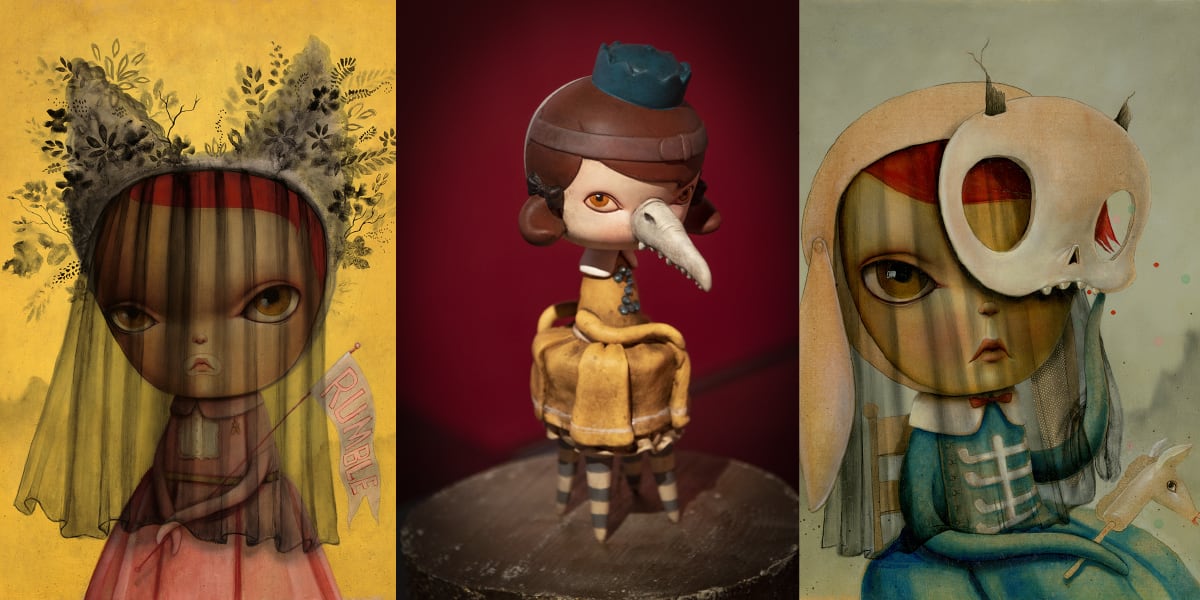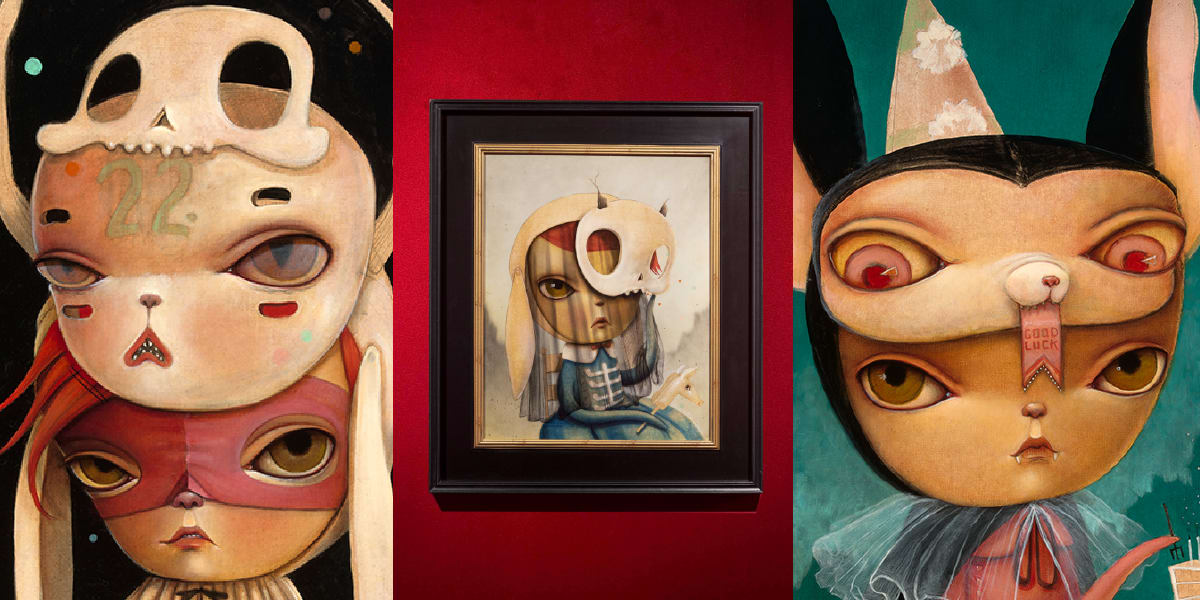
Kathie Olivas plays hide and seek with the symbology of fortune, conveying signs and secret messages through the folds of bows, ribbons, and laces that distinguish the typical character of the artist, marked by the vintage vibe that has made her work prominent and unique.
The iconic protagonists of Kathie Olivas's' work, who already in 2007 were recognised as vinyl figures under the brand Kidrobot, came back more mischievous and delightful than ever to bring a message of positivity and good fortune in a pop-surrealism pattern.
We would like to share with you below the interview Kathie gave on the occasion of the exhibhition that will be in Rome starting November 19 :
You have created a very specific style of portraiture which has since become extremely popular in the pop surrealism field. What would you say is key to this style and what, in your opinion, makes it so magical? Furthermore, how does your art fit in the contemporary art scene on an international level? How would you describe your style and artworks compared to other art movements that currently exist?
For me, the key to forming a style is more about tapping in to a place of shared comfort and euphoria, and nothing comes closer than my childhood and the imagery and characters I connected most to. At the time, my earliest connections to artmaking were in animation and illustration along with my own toys and odd collections.
When I create, i do so by memory or imagination like a form of automatic drawing; I try to channel what things looked like in my mind and I just start creating shapes. I don’t use any reference material other than the occasional odd face or pose I see one of my dogs (my 4 studio mates) make while I’m drawing directly on a canvas.
I think there is a universal connection to play and curiosity; it’s an escape; it provides a disconnect to the daily stress of adult life. I’m not sure if that’s what others connect to, but for me it was about being able to create my own characters that looked more like me, like a mascot, some sort of inner cheerleader. I wanted to see more strong female characters, gender non-conforming characters, unapologetic characters who were disabled or chronically ill. I wasn’t interested in being a princess or being saved by some sort of rescuer.
I’m not sure where I fit in any sort of art scene. My work is very personal and acts as a form of art therapy for me. I’ve been doing sentimental portraits and storytelling since I was a child, and professionally for almost 30 years; it's more of a compulsion and because I’m often told this was some sort of fleeting trend, it’s never been something I’ve felt necessary to dissect at that existential level.




As a very successful artist who has showcased their work worldwide. What does your collaboration with Dorothy Circus Gallery represent to you? Your work presents a combination of cute and sinister, similar to the one that can be found in the original Disney movies or Japanese anime and manga culture. How would you say your own culture inspires your art compared to other international styles you may have been exposed to?
Those were both early influences in how I taught myself how to draw and how to develop storytelling. Japanese anime was presented here on television dubbed in Spanish,
so I definitely have this odd cultural association that will forever be burned into my brain as being part of Latino culture. I grew up in New Mexico where there has always been this bold mix of cultures and during the 80s here you could already see the roots of contemporary “lowbrow.”
I’m not sure if my work is more sinister as much as it is representing a lack of patience or a willful lack of conformity; more of a judgmental stare.
I’ve had a lifelong obsession with apocalypse and a strong desire to warn against catastrophe or stop some inevitable force. There seems to be this shared universal desire to make your own superheroes because there is this repetitious pessimism in your fellow man.

The cute yet bittersweet visual theme is quickly becoming very popular in Asian art. As an American-born artist, and pioneer of this artistic movement, where is your language narrative differentiating from these other artists’ and where is it similar?
About the recent, and very sad, passing away of icon Margaret Keane, who first came up with the “big eyes” movement. What is your relationship with both contemporary and more historical artists, and where would you say the “big eye” movement’s roots reside? Do you think it is appropriate to refer to it as an art movement, or would you trace it back to the eye symbolism in ancient cultures, such as the Egyptian one where eyes were seen as the door to the soul? Or do you perhaps consider it a clever application of human psychology to art?
I think much of the inspiration artists of my generation (pre-internet) gained was more heavily rooted in illustration and advertising. I'm not sure if "high art" fine art had as much of an impact as what is seen everyday and normalized as universal archetypes.
I remember having illustrations by Mabel Lucie Atwell in my room as a child; much sooner than Keene or Mary Blaire, both of who I think made that type of abstraction more appealing and widened an audience for art that crosses into the mass appeal of lowbrow and the expanding voices of female driven narratives.
Tamara de Lempicka, Amedeo Modigliani, and Henry Darger are some of my favorite artists that appear to have influenced this style of art making.
I’m not sure if I connect to the big eye distinction as much as the oddity of abstraction and deformity. My favorite historical paintings were from early American portraiture. These weren’t the most academic painters, they were just the ones who survived the brutality of traveling to and surviving in a new world. There’s an extreme oddness in the “folk” art of that time that always seemed more honest despite their lack of perfection.
I think the psychology of it lies more in how the appearance of youth is so disarming. Children and babies are cute as a defense mechanism; there is an immediate neurological response to protect what we expect to be innocent and helpless.

)
Sculpture can be a tricky form of art, as it presents more difficulties in terms of movement and positioning as opposed to painting and other media. It can in fact be penalised when the material used is very heavy as not only it is harder to handle, but the shipping costs also rise very quickly. As a result, today’s commercial art world is filled with plastic and vinyl sculptures. As an artist who produces both unique one-of-a-kind painted sculptures, and edition toys, what is your artist’s point of view on this?
I have very mixed feelings on mass produced art, especially when the artist is more of an art director, not the artisan. I am very much a hands on/ put my energy into something type of artist; it’s the only way for me to really explore and see what happens in real time, which is the part I connect to most- being at play.
I enjoy the end product of making art toys and making products that are accessible to people who can’t afford original work, but it’s such a stressful process and so much gets lost in translation as you’re working with others who may not share your exact vision. At a larger scale, I rarely enjoy seeing this type of work- it can easily cross over into looking soul-less. there are a few exceptions, but I struggle to understand the ego in producing something larger than lifesize. It’s an odd market that I’ve tried to avoid because it just seems so wasteful.

)
As a leading artist in sculpture and painting, what is your advice to young artists who are at the beginning of their mixed media arts career?
I’m attracted to multiple medias/ mixed media because I have OCD and ADHD. I’m not sure if I would recommend this style of artmaking unless you have these conditions as it’s a big commitment. It requires a good amount of storage space for hoarding supplies and objects you may never find again and a good amount of space for laying everything out as you make work. I’m always working on several dozen pieces in various stages of development so space is always the biggest obstacle. Researching what is archival and what will also hold up over time are also important things to consider.

About the author

Dorothy Circus Gallery





)

)




